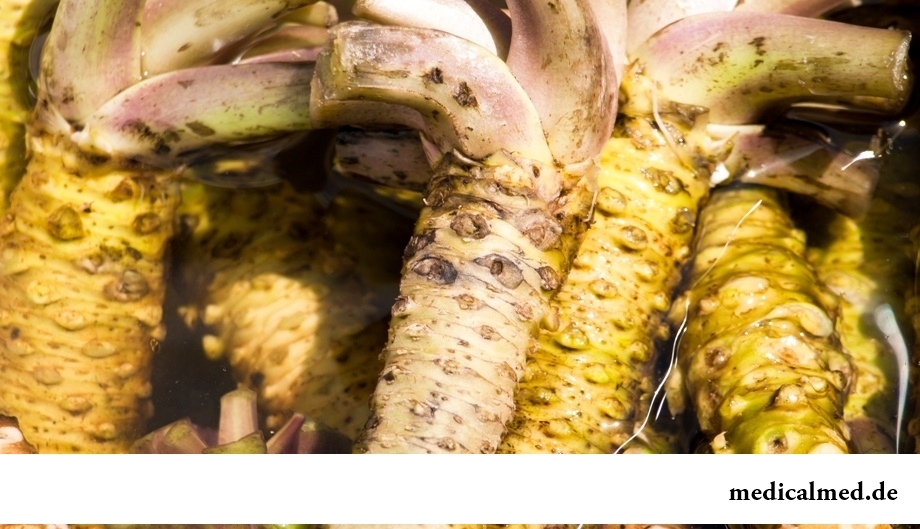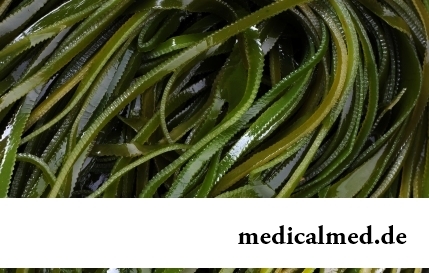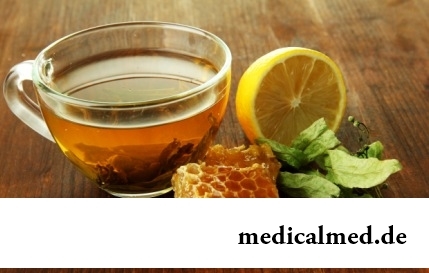





Wasabi
Wasabis call a family plant Cabbage which is the cornerstone of preparation of the well-known Japanese seasoning with the name of the same name. Wasabis also quite often call "the Japanese horse-radish" though the plant actually horse-radish is not, only belongs to one with it to family.

Burning seasoning of green color is made of roots of wasabi which other name – an evtrema Japanese. For this purpose the root is dried and crushed owing to what it finds the expressed smell and the acute taste similar it is rather with mustard, than with burning pepper. Means it that at the use of hot spice in food not language, and nasal passes is stimulated.
Use of a root of a plant in food as seasoning began in far 1396, in the province Shizuoka. The legend says that residents of Shizuoka presented wasabi seasoning as a gift to future shogun. Presentation so was pleasant to it that it began to spread seasoning in other regions of Japan. The speech, of course, goes about the real wasabi or "honvasab", seasoning on the basis of a plant which is widely used and grown up only in Japan. The matter is that conditions under which this look grows, rather specific: wasabi demands the flowing water and temperature which is not exceeding 17 degrees. Seasoning develops the best taste only when roots whose age makes not less than four years are used. In other words, the real wasabi – a product very rare and valuable. The same that is offered at restaurants of our country under the guise of the Japanese seasoning – its imitation made on the basis of horse-radish, food dyes and some spices. It is made in the form of the paste packed into a tube or in the form of powder.
Wasabi – the usual element attached to dishes of Japanese cuisine. It is perfectly combined with fish, including crude, and also with dishes on its basis.
Flowers and stalks of an evtrema Japanese also find the application when cooking: they are used, for example, for creation of tempura – the vegetables, meat or seafood fried in batter.
In the majority of the countries the Japanese seasoning carries the same name, as in the land of the rising sun. Adjusted for accent, certainly. However sometimes seasoning call "the Japanese horse-radish". For example, act in England, Denmark, Germany, Poland and some other countries this way.

Useful properties of wasabi
Wasabi – a product rather low-calorie. In 100 g no more than 109 Kcal contain. Fats in seasoning are absent at all, and the content of proteins and carbohydrates makes, respectively, 5 g and 24 g.
Wasabi is obliged by the advantage to the content of isothiocyanates – the substances which are contained also in mustard oil. They interfere with destruction of an adamantine substance of tooth, suppressing growth of the bacteria capable to cause caries. The same substances take active part in fight against cancer cells, prevention of formation of blood clots, and also have antiasthmatic effect.
It is impossible to avoid the fact that hot spice possesses antimicrobic, antiparasitic and disinfecting actions. Exactly thanks to these properties of wasabi it is used together with crude fish. Thus, one more advantage of wasabi consists in decrease in risk of developing of various infections. Besides, acute taste promotes improvement of work of a stomach and digestion in general.
Of course, best of all, at an opportunity to buy seasoning on its Rhodinum. It is possible to guarantee advantage of wasabi then.
Harm of wasabi
Despite the mass of positive properties of seasoning to use it it is frequent and in large numbers is not necessary. Owing to pungency and sharpness of the Japanese horse-radish persons are not recommended to abuse wasabi with stomach ulcers and intestines, and also that who suffers from an acrimony of a mucous membrane of a stomach. Can do harm of wasabi also to the people sick with cholecystitis, gastritis, hepatitis and pancreatitis in an acute stage.
The American scientists made experiments on mice and came to a conclusion that water-melon juice prevents development of atherosclerosis of vessels. One group of mice drank usual water, and the second – water-melon juice. As a result vessels of the second group were free from cholesteric plaques.

Tea is loved and use almost everything. This drink has tonic properties, contains the tannins capable podavlit...
Section: Articles about health
Dietary supplements (dietary supplements) for the last decades were so thoroughly included into our life that, apparently, it is already impossible to find the person who at least once did not try them. At the same time, most of our compatriots have a vague idea about...
Section: Articles about health
We live during an advertizing era. Daily each person receives a solid portion of persuasive councils about what to eat to be healthy and successful. Products about which we will talk today are combined by the following circumstance: all of them are positioned as the most useful and the most suitable for inclusion in a morning meal. Unfortunately, it is not true: these 10 products do not suit for breakfasts at all....
Section: Articles about health
Insufficiently strongly expressed sexual desire or lack of satisfaction from sexual contacts can test time from in...
Section: Articles about health
For many spouses the question of planning of a family is one of the main. The problem of the choice of effective and safe contraceptives at the same time comes out on top. Russians still not often resort to operation of a vasectomy extremely popular in the USA...
Section: Articles about health
All of us, unfortunately, should face flu nearly an every year. It would seem, so frequent disease has to be studied already up and down, and each person, at least once to them had (and the number of such people in our country aims at 100%), has to know the basic rules of its treatment. However as shows experience of doctors, there is no it, and often people, self-confidently thinking what is known as it is necessary to be treated, make mistakes....
Section: Articles about health
History of use of an anesthesia during operations contains more than 160 years. Annually in the world hundreds of thousands surgical вм are carried out...
Section: Articles about health
For residents of the countries of Southeast Asia various algas are an obligatory component of a daily diet. Their popularity is connected not only with high tastes, but also with numerous curative properties. Russians are a little familiar with...
Section: Articles about health
Each of us faces from time to time that other people need the immediate help. We react to it differently: one at once call doctors and police, others rush to victims and try to save them independently. Some pass by at all … Certainly, desire to help the neighbor who got into trouble, quite naturally for any decent person. However not everyone understands that to work in a similar situation, being guided by exclusively good...
Section: Articles about health
The cosmetics intended for improvement of a condition of skin, nails and hair are used by each woman. Expenses on регуля...
Section: Articles about health
Almost each of us during life faced dissatisfaction with own body. At such moments, as a rule, we begin to shame ourselves, urgently we go on the most rigid diet promising minus of 10 kg in a week, or we exhaust ourselves in the gym to полусм...
Section: Articles about health
For the person who daily since morning gathers for work it is very important to wake up vigorous and ready by day of work. Actually, each of us experiences difficulties with this, at first sight, simple business from time to time. After night rest exert impact on a condition of an organism the weather which collected for several days fatigue, household and office problems, quality of a dream and many other factors....
Section: Articles about health
Cold – a state known to everyone which is followed by cold, cough, high temperature, a pharyngalgia. Often перво...
Section: Articles about health
Several decades ago the basil (the district khan, реан, Reagan) was considered as a part of the Caucasian or east cuisine, but today it strongly took the place on tables of Russians. Greens of this plant possess a strong, pleasant smell and specific fresh taste, because of to...
Section: Articles about health
Reactive pancreatitis - the disease which is characterized by inflammatory process in a pancreas which arises most often because of excess activity of digestive enzymes. It − the emergency state which treatment has to take place in surgical department under control of doctors. The acute inflammation of gland can become the reason of its transition to a chronic form, and also development is purulent - necrotic pancreatitis which the extensive necrosis of fabrics can follow. Zabolev...
Section: Articles about health
In consciousness of our many compatriots idea that folk remedies if no more эфф strongly took roots...
Section: Articles about health
The name of this disease precisely reflects the problem reason: it consists in the bra fastener pressure upon a certain zone of a back. At the same time one of vertebrae of chest department of a backbone is as if blocked and loses mobility, and falling on it is nude...
Section: Articles about health
A little more than a century ago goat milk was a traditional food stuff of most of Russians. Unfortunately, today on tables of our compatriots it appears extremely seldom. The reason that the use of so useful product practically came to naught, not only in very modest volumes of its production and, respectively, rather high cost. Potential consumers are just insufficiently informed on unique properties of goat milk and that advantage which...
Section: Articles about health
Epilepsy is one of widespread neurologic diseases. To parents, whose children suffer from this illness, it is necessary...
Section: Articles about health
Smack in a mouth can arise in the natural way – as a result of lack of morning hygiene or reception of the corresponding food. However in certain cases its existence is a sign of certain pathologies, and allows to reveal an illness at an early stage. In we depend...
Section: Articles about health
There is an opinion that at low temperatures safety of products is ensured longer and better thanks to what the refrigerator is considered the most suitable place for storage of food. In most cases it is fair, however there is a number of products for which low temperatures – the main reason of their premature damage. Storage in the refrigerator leads to their bystry rotting, emergence of a mold, is followed by loss of vitamins and tastes. What products it is better to remove...
Section: Articles about health
Visit of doctors – business not the most pleasant, and many people do not hurry to undergo necessary planned inspections. Such behavior...
Section: Articles about health
Since the moment when the child becomes a school student, his sight begins to be exposed to the strengthened loadings which are supplemented with viewing of animated films and long computer games. During this period of life of the child development not completely created bodies to a zra...
Section: Articles about health
The saying "the rich do not know how the other half lives" is known to all. In a broad sense it is that we can not always understand the person whose features of a state are unknown to us. If with physiological characters of diseases the situation is more or less clearly (having noticed them, we realize that to the person nezdorovitsya), then with symptoms of the illnesses affecting the mental sphere everything is much more difficult. Not absolutely usual behavior is quite often perceived surrounding as a ridiculous eccentricity, or that much ху...
Section: Articles about health
All are familiar with cold, and practically everyone believes that he has sufficient knowledge and experience that correctly to treat it. N...
Section: Articles about health
It seems, quite recently you brought the baby from maternity hospital, but time flew by, and here it is already going to join the first in life children's collective. How to prepare the child for visit of a garden? What needs to teach him to facilitate process адап...
Section: Articles about health
Each person has easy indispositions which he transfers "standing", trying not to ask for medical care. Arguments at the same time are adduced same: "it is a trifle, itself will pass", "I have too many important issues", "there are no wish to spend time for doctors", etc. At good shape of health, normal working capacity and lack of suspiciousness dislike for complaints to such problems is quite natural. It is not the most correct, but very widespread type of behavior. I am glad...
Section: Articles about health
